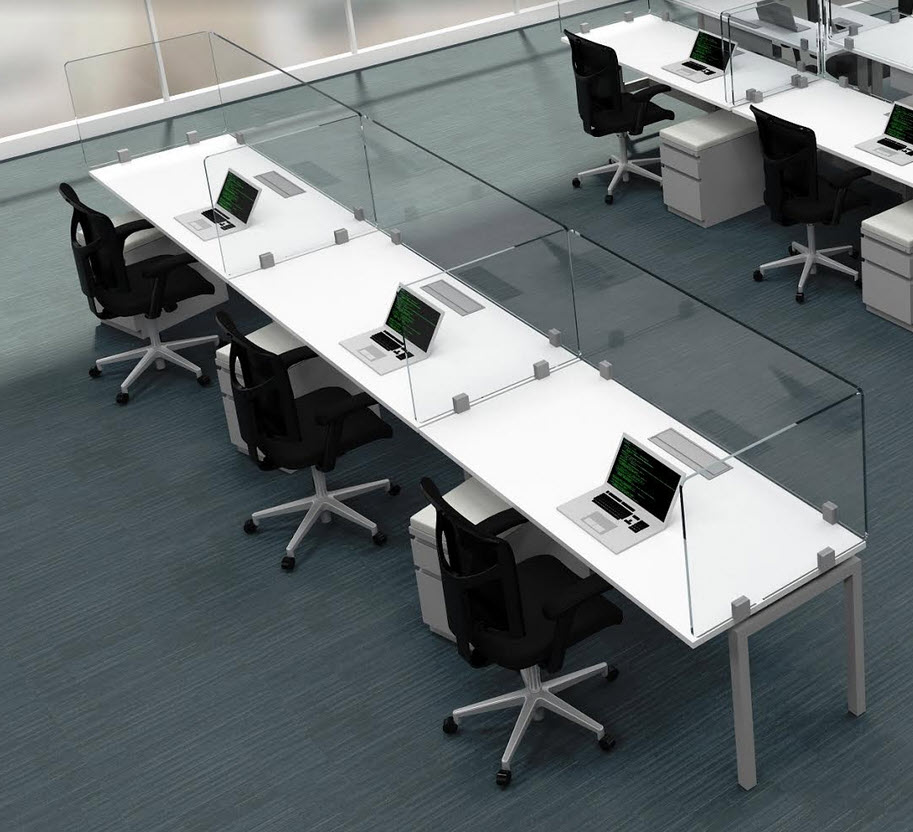The Coronavirus, or COVID-19, has for the foreseeable future changed how we spend our time indoors and outdoors. Along with social distancing practices, people are starting to think about germs and infection like almost no other time in modern history. The behavior modifications that follow are changing protocols, and changing environments.
One of the most common environmental modifications for workplaces and customer-facing positions are personal protection screens. These protective shields are designed to block microbes from landing on you and potentially getting you sick.
Although some say social interactions are negatively impacted by personal protective screens, they do have a major impact on your probability of getting sick. Every time we speak, small droplets of saliva are shot into the air. Those droplets can spread disease, which is why during COVID-19 a distance of six feet is suggested for proper social distancing.
At that range it’s unlikely you’ll be infected by someone talking in your general direction, but often during work situations we can’t stay quite six feet apart. For instance, fast food establishments have begun installing personal protective screens at their drive-thru windows so orders can still be handed to cars while blocking a chance for infection.
Many convenience stores have already implemented personal protective screens for customer-facing employees. Companies whose employees must report to an office are starting to catch the drift that these barriers keep people safe and able to work.
What About Other Safety Measures?
It should be made clear that personal protective screens are not a complete protection for getting sick. Touching money or work materials handled by someone with COVID-19 can still spread the virus, so protective gloves are a must. When possible, have hand sanitizer readily available for your employees and instruct them to use these as often as possible.
A personal protective screen is most valuable where employees experience consistent and regular in-person interactions. Cashiers, clerks, and other customer-facing employees are often at a desk or station, and most all of their responsibilities can be carried out behind a barrier. And with one of these screens, they don’t have to worry about being coughed on or sneezed on by someone who is sick (in fact, some of the brand names include the word “sneeze”).
How Do Personal Protective Screens Work in the Workplace?
If you’ve ever been to a bank where the tellers are behind a glass window, then you’ve already experienced personal protective screens.
Models coming out during the Coronavirus Pandemic are smaller and require a less-extensive installation than teller windows. Often, they are installed with either screws or suction cups, and come in many sizes to accommodate all different sizes of protective needs.
Protective desk and counter screens are the most popular type of personal protective screen. Business owners and managers who need to outfit their business with these barriers have many models and brands to choose from.
Some brands, like ShopPOPDisplays, create customized personal barriers and protective desk and counter screens to fit any size you may need for your business.
Protective Desk and Counter Screens
Frame Displays
Frame Displays is a North American company with over 22,000 clients. They specialize in designing personal protective screen solutions for individual spaces, but also carry many products and components.
This is an example of one of their products, a screen 23.6” x 23.6” with a small opening along the bottom of the form. This model would be perfect for an opening two feet wide and at least two feet high.
Source: https://www.framedisplays.com/cocoshc66frp.html?utm_source=googleshopping&utm_medium=cpc&utm_campaign=cocoshc66frp&gclid=EAIaIQobChMIyd-q8O3S6QIViovICh2heQAyEAYYASABEgL74PD_BwE
Carl Roth
Carl Roth is a German company that specializes in laboratory materials. They offer personal protective screens that are thicker and more durable, often to be used in lab environments.
This is an example of one of their products is 2.7’ wide and 2.4’ tall, and features closable side planes to help prop or resize the piece.
Source: https://www.carlroth.com/com/en/protection-screens/protective-screen-sekuroka-with-side-panels-type-750/p/2968.1
fluid concepts
fluid concepts is a Canadian company that features many protective desk screens in four specific forms: linear, enclosed, and a sparse “all-clear” model.
Many of fluidconcepts’ screens are aluminum-framed, offering stability and a potentially attractive decorative accent.
Source: https://www.fluidconcepts.ca/Protective-Screens-s/628.htm
Sneezely
Sneezely is a new company offering a couple types of personal protective barriers perfect for doctor’s offices, retail establishments, and office environments. They offer a portable and stationary model with a good degree of customization.
Source: https://sneezely.com/?gclid=EAIaIQobChMI3IGRsvLS6QIVBIzICh3dNAHvEAAYAyAAEgLhDfD_BwE
Should I Buy Personal Protective Screens?
The answer is yes. Personal protective screens are not only a way to protect your employees; you also send a clear message that you care about the health of your customers. Personal protective screens send a message that, while you are ready to do business, you’re fully prepared to do it safely and in accordance with federal, state, and local government guidelines. Happy shopping, and stay safe out there!
Contact us today to find the perfect Protection Screen for your business.
(516)-768-9033



